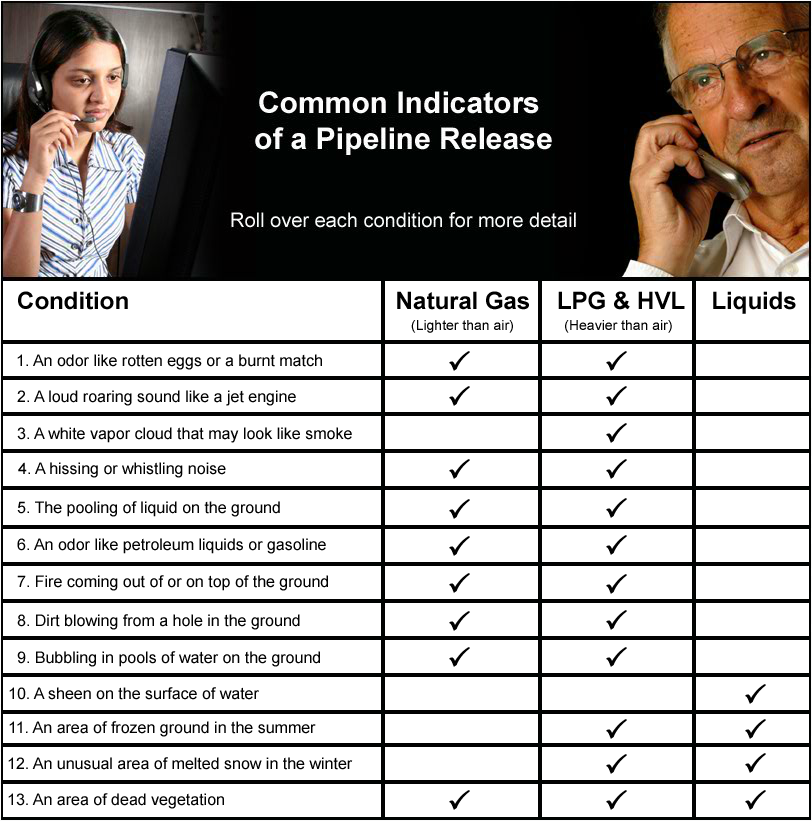Introduction - "Lessons Learned"Proceed »
Pipeline OverviewProceed »
Receiving the CallProceed »

An odor like rotten eggs or a burnt match - Natural gas, propane and butane are odorized with sulfur based chemicals for early detection. They are often described as "rotten eggs" or "burnt math". Unfortunately, these odors may not always be present. They can be diminished by sensitivity or scrubbed out by certain soils as well. Also, raw petroleum products from the ground can also have sulfur in the form of hydrogen sulfide gas (H2S) which the industry refers to as "Sour gas" or "Sour Crude" oil.
A loud roaring sound like a jet engine - The pressure released in a pipeline release can cause extreme air movement that will make a roaring sound like a jet engine.
A white vapor cloud that may look like smoke - Aerosolized liquids and liquid petroleum products will create a cloud or mist of product.3.A white vapor cloud that may look like smoke - Aerosolized liquids and liquid petroleum products will create a cloud or mist of product.
A hissing or whistling noise - Low pressure gas releases will create hissing or whistling noise.
The pooling of liquid on the ground - Hydro-Carbon Liquids and even LPG like propane will linger in the area for a long time until they evaporate.
An odor like petroleum liquids or gasoline - Many liquid are hydrocarbon based and possess components that are referred to aromatic hydrocarbons. Aromatica give off the odors people recognized as flammable liquids like gasoline and diesel fults.
Fire coming out of or on top of the ground - The gasses and other flammable products find an ignition soure and are burning on the surface.
Dirt blowing from a hole in the ground - The high pressure of the product forces debris, dirt, soil even water out of a hole.
Bubbling in pools of water on the ground - Gaseous products will rise naturally and many liquid products being lighter that water rise as bubbles to the surface.
Sheen on the surface of water - Sheens are a very thin amount of petroleum liquids. Most hydrocarbons which are lighter than water and will float on water.
An area of frozen ground in the summer - As gaseous products are released they cool. Large releases could cause the ground to freeze or the moisture i the air to change to fog.
An unusual area of melted snow in the winter - products being subsurface are usually warmer that the surface.
An area of dead vegetation - Common to all three types of products pipeline operators use discoloration as an indication a pipeline has a leak.
Exercise #1 - Is there a Pipeline Release?Pipleline Release Indicators >

Click on CALLER 1 to listen to his 911 call. Then answer the questions below.
Does this call indicate a pipeline release?
What type of release do the caller's observations indicate?
Click on CALLER 2 to listen to his 911 call. Then answer the questions below.
Does this call indicate a pipeline release?
What type of release do the caller's observations indicate?
Click on CALLER 3 to listen to his 911 call. Then answer the questions below.
Does this call indicate a pipeline release?
What type of release do the caller's observations indicate?
Exercise #3 - Is the caller in Danger?Immediate Danger Protocols >

Click on CALLER 1 to listen to his 911 call. Then answer the questions below.
Is this caller in danger?
Based on the Immediate Danger Protocols what instructions would you give to the caller? Check all that apply. To review the Immediate Danger Protocols, click on the button below.
Click on CALLER 2 to listen to his 911 call. Then answer the questions below.
Is this caller in danger?
Based on the Immediate Danger Protocols what instructions would you give to the caller? Check all that apply. To review the Immediate Danger Protocols, click on the button above.
Click on CALLER 3 to listen to his 911 call. Then answer the questions below.
Is this caller in danger?
Based on the Immediate Danger Protocols what instructions would you give to the caller? Check all that apply. To review the Immediate Danger Protocols, click on the button above.






